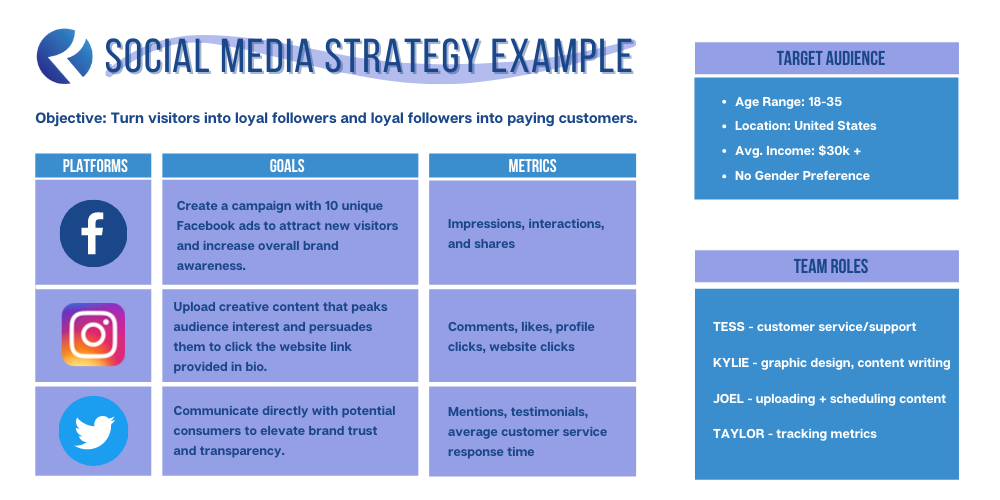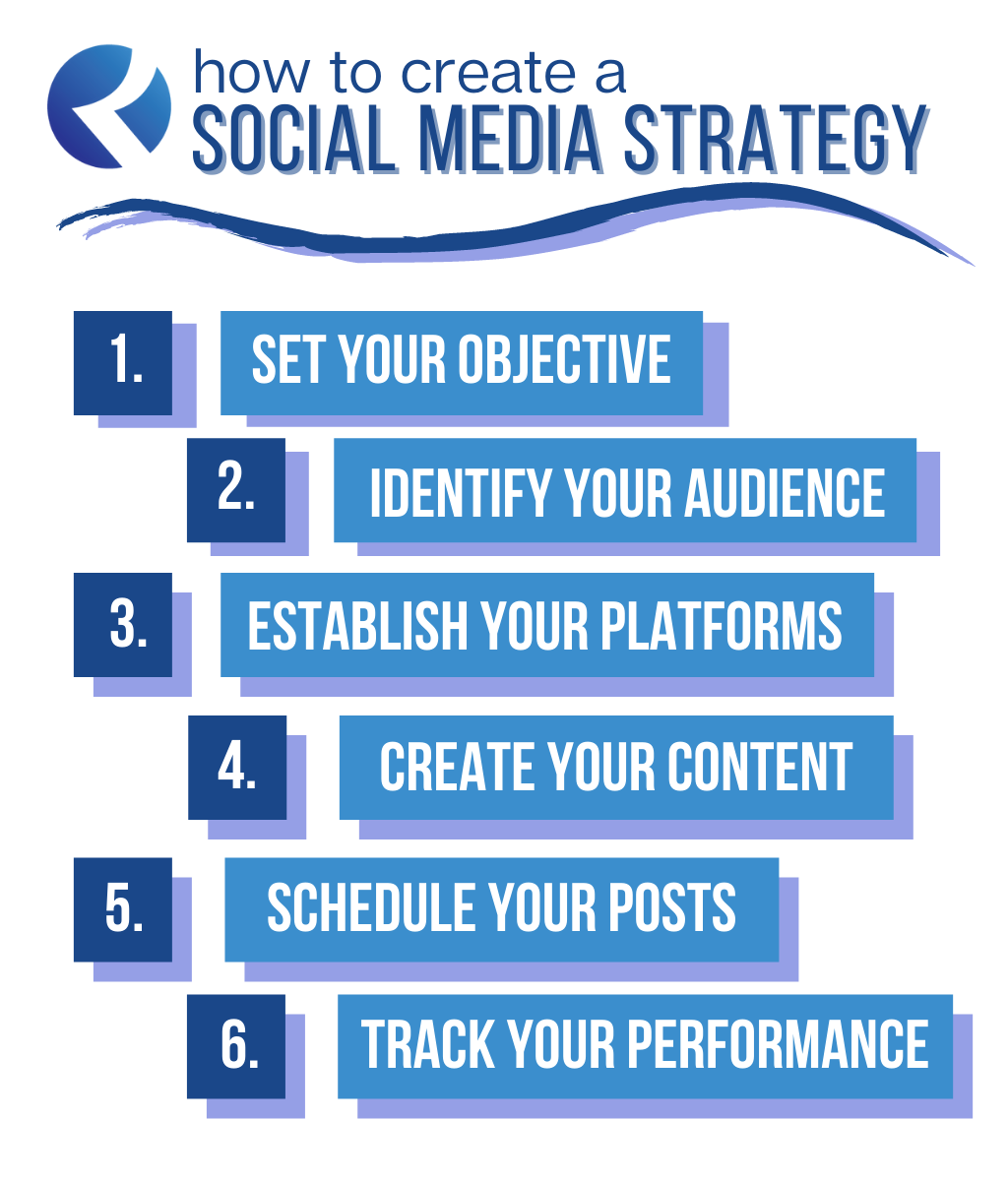
How To Create a Social Media Strategy
Kristyn Miller
Table of Contents
Never underestimate the power of a good social media strategy. It takes a lot more than simply posting content intermittently and throwing in the occasional hashtag here and there to enact a successful strategy. In fact, to even consider it a “strategy” in the first place, you must take the necessary steps to curate one.
Otherwise, you are simply posting to a social media platform with the mere hope that it benefits you or your business without considering the necessary elements it takes to actually do so.
In this post, our social media management experts at Kiopi will inform you of what a social media marketing strategy is, why it’s important, and how to create one.
What is a Social Media Strategy?
A social media strategy, like any other kind of strategy, takes place long before any “plan of action” comes to fruition. Essentially, a social media marketing strategy is a blueprint that establishes the agenda behind your social media activity. It answers the questions of what you will be doing, when you will do it, and why you are doing it in the first place.
At its core, a social media strategy requires two main elements: a goal you’d like to achieve and a plan for how to get there. Broken down further, your strategy should document all of your social media objectives, the techniques you’ll employ to attain them, and the metrics you’ll use to track their success.
Your social media marketing strategy should also include a list of all of the social media accounts you plan to use as well as goals unique to each platform. Of course, these objectives should be in line with your company’s overall digital strategy. Your strategy can (and likely should) also spell out your team’s roles and responsibilities when it comes time to actually implement the social media plan.
Social Media Strategy Example
Here is an example of what a well-thought out social media marketing strategy might look like:

Why Strategies for Social Media are Important
It should come as no surprise that as the times continue to change to accommodate the fast-paced world of technology, so have our business practices. A lot of what that looks like nowadays is adapting to the world of social media and working to boost your online presence by way of digital marketing.
Social media platforms allow us to reach millions of individuals all around the world in the time it takes to bat an eye. Whether you’re using social media for a small business or a multi-million-dollar corporation, it is imperative that meet your current and future consumers where they are searching. In other words, you want to make sure your company’s brand and/or products are easily visible and accessible to prospective online customers.
Just as you had to develop a strategy to create your business, you need to develop an effective social media strategy to maintain it and help it expand even further. It is a common and often necessary component of any successful business plan. It may complement additional marketing efforts or otherwise even replace them entirely. As a result, a good social media strategy can help guide your actions and determine whether your marketing efforts are succeeding or not.
Other benefits of a successful social media marketing strategy include but are not limited to:
- Increasing brand awareness
- Gauging how the general public feels about your business
- Using social media advertising to promote products or services to target audiences
- Selling products or services to target audiences
- Building a sense of trust and transparency with potential customers
- Providing customer service in a more accessible manner
- Tracking and measuring your performance through social media analytics
How To Create a Social Media Strategy
Though there is no one-size-fits-all approach to creating an effective social media strategy for your business, there are some key elements that you should try to keep in mind. Below, we’ll take you through all the steps that we believe are necessary for creating and implementing a successful social media strategy. (You may notice that these steps are very similar to those of creating a social media campaign. That is because a social media strategy and a social media campaign essentially go hand-in-hand, as they are both planned marketing efforts that use social media to obtain a business goal. In this case, the below steps apply to the curation of any social media campaign strategy.)

1. Set Your Objective
The first (and arguably most important) step in creating a social media strategy is to lay all of your goals out on the table and set your specific objective. This may be one or multiple goals relative to one another that you wish to accomplish. Remember, however, that the more specific your goal is, the more effective it will be. You should also choose a goal that can be easily measured and attainable.
For example, setting your goal as simply “going viral” or “driving sales” is not an effective strategy because it is not specific and thus, cannot be easily measured. What is viral to you? Is it upwards of 10k likes, comments, or shares, or does it require millions of these engagements? How many sales do you wish to drive? How will you know when you’ve met your goal?
A better social media strategy example might be “achieving 20,000 or more views on an Instagram video showcasing a featured product to promote a special offer” or “using social selling techniques to generate interest in our product and leading at least 15% of prospects down the marketing funnel into successful conversions. These are objectives that, depending on your current following base and digital presence, are much more attainable and can be easily measured.
2. Identify Your Audience
When creating a social media strategy, it’s important that you know who your target audience is, what they’re searching for, and where to find them. It is much easier to engage with fans, followers, and customers on social media when you get to know them as real people with real desires, needs, and expectations. As a result, you’ll be able to generate material that speaks to them directly, making them more likely to engage with your content. It’s also necessary if you want to convert your social media following into actual paying clients.
Some of the target demographics you want to pay attention to when it comes to your target audience include:
- Age
- Region/Location
- Interests
- Average Income
- Gender Identity
- Job Title/Industry
3. Establish Your Platforms
By analyzing your target audience, you should be able to get a clearer picture of which social media platforms will work best for implementing your strategy and accomplishing your goal. Once you figure out where your audience is, ask yourself what they expect from each platform. Do they expect fun product tutorials or do they expect customer service representatives answering serious questions and concerns? Are they looking for company reviews and business details or do they seek a special eye-catching offer? Asking yourself these questions can help you plan content accordingly and best meet your audience’s expectations.
4. Create Your Content
Next, you’ll want to focus on your social media content strategy. As we just mentioned, by determining what your consumers expect from each platform, you can then use that information to tailor content specifically for each platform. For example, when posting to Twitter, you have a strict character limit. This is why many businesses opt to utilize this platform as a means of customer support and perhaps the occasional meme. Meanwhile, when posting to Instagram, businesses often do their best to showcase their creativity by way of exciting photo and video content. So, if your goal is to open up a new pathway for customer support and communicate with individuals directly, Twitter might be the best route for you. However, if you wish to increase visibility with unique photo advertisements, you may consider utilizing Instagram or Facebook advertising to execute your strategy.
5. Schedule Your Posts
Once you’ve created content with your goals in mind, the next step of your social media marketing strategy is to ensure that it gets posted. Whether it includes a few images or an entire month’s worth of campaign material, your strategy relies on the content being posted at a predetermined time and date, typically one that best reflects your target audience’s online activity times.
The best way to make sure your content is posted where it needs to be when it needs to be is to take advantage of a social media content calendar. A content calendar not only allows you to schedule future postings, but also helps you keep track of what’s already been posted as well as coordinate your efforts with other members of your team. Such a calendar can be very useful for people who want to provide regular material across various social media platforms, establish and maintain a certain brand image, figure out where each account excels and falls short, and adhere to a specific timeline.
6. Track Your Performance
You can’t always expect every strategy or campaign to perform perfectly the first time around. As you begin to put your strategy into action, you may discover that certain techniques don’t work as well as you thought, while others perform even better. This is why it is critical that you keep track of your strategies’ effectiveness by use of a social media analytics tool. Measuring your success with the help of such a tool is the best way to discover what techniques are working for you and which ones aren’t. Understanding your metrics based on consumer response (or lack thereof) will help you improve your approach the next time you choose to implement a new social media strategy.
Perfect Your Social Media Strategy with the Help of Kiopi
By turning to social media and online marketing to help boost your brand’s image and increase consumer engagement, you’re already on the right track. Remember, however, that it takes a lot more than just creating an account and haphazardly posting to reap the benefits of social media marketing. Instead, it’s critical that you remain on top of social trends and have a solid understanding of social media management skills to include into your strategy in the fast-paced, ever-changing world of social media. When you integrate useful tools such as Kiopi into your marketing strategy, you’re sure to put your best digital foot forward. Sign up for a free 14-day trial with Kiopi today and see how much easier social media management can be for you.

